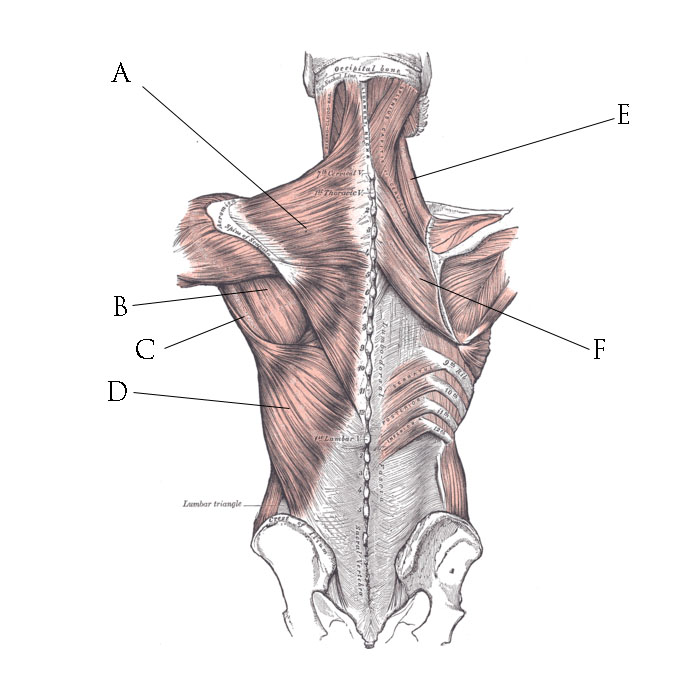By John Higgins — As back pain is one of the most common medical problems in the USA, it’s not surprising that quite a few cyclists experience this problem during a ride. Usually back pain is felt as a broad ache from tension or fatigue, but sometimes it can be a localized and sharp pain. So what are the common causes and is there a remedy?
If you only experience back pain during or immediately after a ride, then there is likely to be a high correlation between the pain and the activity.

A – Trapezius,
B – Teres Major,
C – Teres Minor,
D – Latissimus Dorsi,
E – Levator Scapulae,
F – Rhomboid Major.
Source: Gray’s Anatomy of the Human Body, 20th Edition (1918), Public Domain
Possible Causes
Pre-existing back conditions: If you have suffered trauma resulting in disc compression, herniation or lumbar fractures, then you will already have a good understanding of this cause. But older cyclists can also have disc degeneration or arthritic conditions that contribute to back pain – and these issues may not yet have been diagnosed.
Leg Length discrepancy: Unless you are riding on flat pedals, you are mechanically attached to the bike under your feet. Therefore if one leg is a bit shorter than the other, your back experiences an asymmetrical tug each pedal stroke. There are two types of leg length discrepancy: Structural – in which a leg bone on one side is a different length to the other; and Functional – which could result from a muscle imbalance or foot pronation.
Effort exceeds capacity: Often a back ache is from fatigue, and fatigue can come from riding further, harder, or over rougher terrain than you are accustomed to. As well as your leg muscles running out of steam, so can your core and back muscles, which play a key role in stabilizing your pelvis and countering the forces generated by your leg muscles as they power the pedals. As these muscles fatigue they have to work even harder to provide stability, and so the problem worsens. You get the idea.
Weak Core: This is closely related to the above point. Cycling uses core muscles to support the back and stabilize the pelvis, but cycling on its own doesn’t develop and strengthen core muscles. If you have a flabby core you are going to be more prone to back ache.
Positional compensation: If your position and posture on your bike are not ideal, this will show up in various areas, including your back. Common compensations that impact your back include:
- A saddle too narrow can result in sitting skew-wonkas on the saddle to get at least one sit bone firmly planted, twisting your pelvis and demanding more support from the back, or there is not enough real estate under your butt to offer structural support for the pelvis so the back has to work harder to compensate for this.
- A saddle causing perineal problems (pressure, numbness) can lead to a subconscious pelvic roll back to relieve soft tissue pressure and solve one problem but create another in the form of a rounded thoracic area spine and increased strain on the lower back muscles to hold a riding position.
- A saddle too high may cause pelvic rocking to help reach the bottom of the pedal stroke, adding unnecessary activity to the lower back, leading to back muscle overuse, fatigue and tension.
- A handlebar too far away requires extra extension to reach the bars, and consequent back tension to counter the over-reach.
- If you are sitting too upright on the bike and trying to generate power, you are trying to fire an arrow without drawing the bow. There is insufficient tension in your kinetic chain to anchor the pelvis and activate the legs. So why does not enough tension create too much back tension? All the parts aren’t working together so the lower back takes on victim status and carries the load that should be more evenly shared.
Back Relief
Pre-existing back conditions are actually a common reason people take up cycling due to the low impact nature of the sport. However careful consideration needs to be given to the bike fit position so as not to protect the back and not add further aggravation.
Functional leg length discrepancy is best corrected by a body work specialist like a PT or chiropractor. Structural leg length discrepancy needs to be confirmed with a standing AP X-ray, with a diagnosed difference greater than 1cm to warrant correction. This may be achieved through the use of an orthotic, but due to the low volume of cycling shoes it is more commonly corrected by use of external cleat shims.
Strength and conditioning training is often recommended to cyclists, but not so commonly practiced. It is the best way to protect your back from the demands of cycling and to increase your capacity to expend greater effort. Particular attention to core work is important for generating power without creating undue back strain.
Positional compensations can be hard to diagnose on your own, as they are usually sub-conscious. Start by paying attention to how your back feels while riding, and experiment with adjustments and postural changes to see if you can effect improvement. The external perspective of a professional bike fitter is often required to firstly identify and then reduce any compensations through changes to your equipment and riding position.
Cycling should be experienced without undue or persistent back pain. If you do get back pain while riding there are usually identifiable reasons for it, and corresponding remedies. Seek advice, and do your core work!
John Higgins wants to elevate your cycling experience. He operates BikeFitr – an independent bike fitting studio, and Fit Kit Systems – supplying equipment and education to bike retailers and fitters. Contact: john@bikefitr.com








